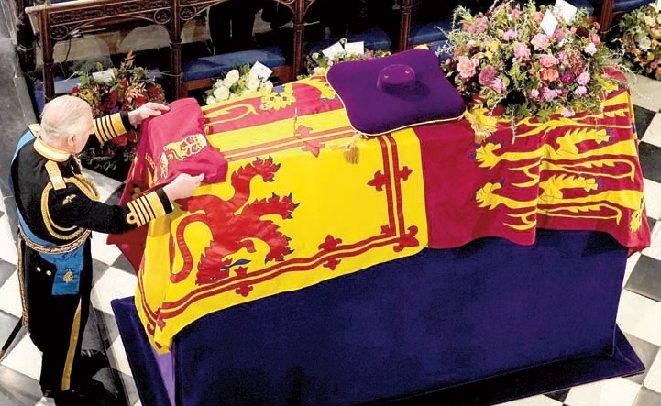King Charles III in front of his mother’s coffin at St George’s Chapel, Windsor Castle
THE WORLD, especially countries which constituted the British Empire of which Ghana was a part, yesterday watched the majestic state funeral for Queen Elizabeth II, who passed on recently at the age of 93.
This preceded her interment at St George’s Chapel within Windsor Castle.
Having been on the throne for 70 years, the state funeral was being watched for the first time by many who, of course, were born after the ascension to the throne by the departed monarch.
Expectedly, hundreds of heads of state, diplomats and others turned up in London to join in the farewell procession for the Queen, whose interment yesterday marked the end of the second Elizabethan age.
Those who described yesterday’s funeral as the greatest state funeral for a monarch in contemporary times are on point.
The weeks of rehearsals of the various units of the British military, whose traditions have been passed on to Ghana, were tested by the funeral and burial parties who displayed their drill skills.
The infantry, in their Number One Service Drills of red, black and gold around the neck and the edges of their epaulettes, the Royal Navy’s white drill and their unusual drill of not banging, not forgetting the blues of the Royal Air Force, all gave the programme a sense of seriousness and military precision.
Tens of thousands of British spectators and millions of others in former countries which made up the protectorates of the former maritime power watched the elaborate procession along mapped out streets in London.
For the London Police and other security apparatuses of Britain, yesterday’s programme and even those before it tested their policing skills to the seams.
They did not have to get it wrong, and so London and the funeral procession streets were beehives of security activities as both uniformed and plainclothes paced up and down, so nothing untoward took them off guard.
From central London, the Union Jack draped coffin moved to its resting place at Windsor Castle, after queenly state funeral at Westminster Abbey, where the royal family and world leaders paid respects to the ‘Queen of the world’.
From Tamale to New Delhi, the deceased traversed these places as she surveyed the territories of the kingdom bestowed upon her by her forebears.
The coffin was carried on a Royal Navy gun carriage from the funeral service to the Wellington Arch near Hyde Park. It was then transferred to a state hearse for the journey to Windsor Palace, where another service and a private burial at St George’s Chapel took place besides her husband and parents.
Earlier, Westminster Abbey’s tenor bell tolled 96 times, once for each year of Elizabeth’s life, before her coffin was carried inside for a state funeral.
Behind the casket followed her eldest son, Charles, who at age 73, is finally taking the reins of the kingdom.
Then, for the next hour, there were tributes to Elizabeth and hymns that culminated in two minutes of silence observed by those in attendance and across the country.
The role of the clergy could only march the military in terms of significance.
In his sermon, Archbishop of Canterbury, Justin Welby, recalled how when Elizabeth turned 21, she vowed, in a radio address to her millions of subjects around the world, to spend her life serving the British nation and the Commonwealth.
“Rarely has such a promise been so well kept,” he said.
While Welby spoke, the thousands gathered near Windsor Castle watched the unfolding ceremony on huge screens erected for the momentous occasion. Many had tears in their eyes.
“We just felt we had to come,” said Louise Austerfield, 42, who was visiting from West Yorkshire, in the north of England.
Toward the end of the ceremony, the mourners gathered in the ancient edifice sang “God Save the King,” a version of the national anthem that had not been heard there in 70 years.
By A.R. Gomda with additional Files


